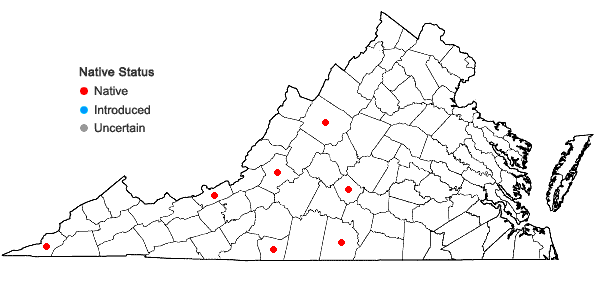Silphium asteriscus L. var. latifolium (Gray) Clevinger
No images available.

Detail
- Family
- Asteraceae
- Botanical Name
- Silphium asteriscus L. var. latifolium (Gray) Clevinger
- Common Name
- Broad-leaved Rosin Weed
- Synonym(s)
- Silphium trifoliatum L. var. latifolium A. Gray
- Flora of Virginia Name/Status
- Silphium asteriscus L.
- Comments
- Formerly treated as a variety of Silphium trifoliatum; new combinations are made by Clevinger in Novon 14:275-277 (2004). Map incomplete; many Virginia specimens have not been determined to variety. However, recent field experience has shown that the characters defining the vars. of this species are often not well correlated, and that individual plants with differing characters often co-occur. Varieties latifolium and trifoliatum are plants with glabrous to sparsely hairy leaves and stems. Var. latifolium is reportedly distinguished by being less pubescent than var. trifoliatum and having opposite leaves (vs. mostly whorled) that are broadly ovate (vs. lanceolate or lance-ovate). The distinction is confounded in our area by populations of whorled-leaved plants with broadly ovate leaves, and populations of wholly opposite-leaved plants with narrow leaves. Conservatively, we are treating all of these aberrant populations as forms of var. trifoliatum, and have mapped only specimens that appear to most completely conform to the characters of var. latifolium. The core range of var. latifolium is in AL-KY-TN, and the most convincing Virginia specimens have been collected near this core range in Lee County of far southwestern Virginia.
- Habitat
- As a whole, the species inhabits dry-mesic to dry (occasionally mesic) open forests, woodlands, barrens, riverside prairies, clearings, old fields, meadows, and road banks; it is especially common in base-rich soils. The species is frequent in the mountains and Piedmont, infrequent in the Coastal Plain. Specific habitats and distribution data for var. latifolium are sketchy at present, but it appears to be less common than var. trifoliatum, with a distribution concentrated in the southwestern part of the state. Numerous specimens that appear to be intergrades with var. trifolium occur state-wide.
- Native Status
- Native
To save this map, right-click (control-click for Mac users) on the map and choose "Save Image As...".